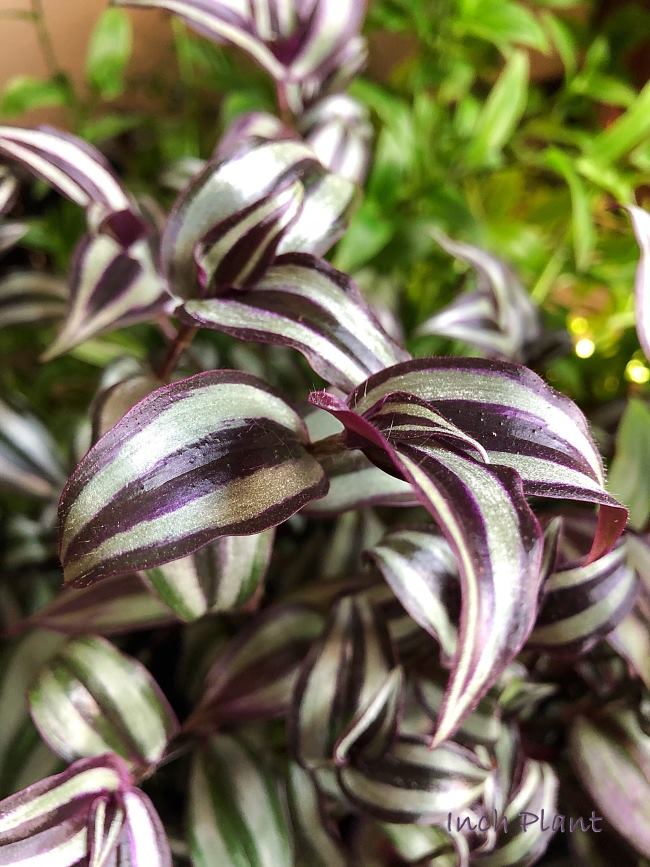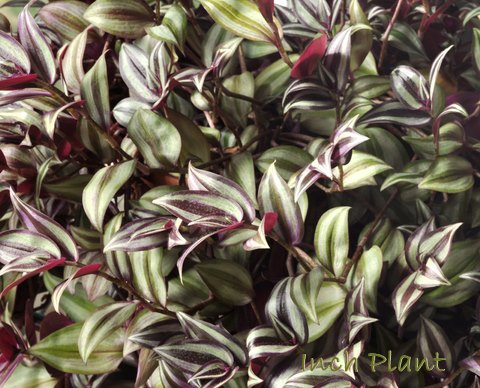Inch Plant Care
Botanical Name: Tradescantia zebrina
Light, humidity and water are the keys to Inch Plant care. Give this tropical native what it wants and it will reward you with colorful, glistening foliage, making it a stunning houseplant all year round.
Its long, fleshy stems are densely covered with lance-shaped leaves that are about 2 in (5 cm) long. Each green and purple leaf is marked with 2 broad silvery bands, and is dark purplish underneath.
Small, 3-petaled flowers may appear in spring, but they're not showy compared to the colorful foliage.
Best known as a hanging plant, the Inch Plant is easy-care and fast-growing. To show it off, display your trailing houseplant in a plant hanger, decorative plant sconce or on a plant stand.
 Coloful foliage makes Inch Plant an ever-popular trailing houseplant. Photo: Tammarazzi
Coloful foliage makes Inch Plant an ever-popular trailing houseplant. Photo: TammarazziInch Plant Care, Solutions and Special Helps
Pinch and prune. Pinch stems back to keep Inch Plant from getting too leggy. The best time to prune is in spring and summer, during this plant's most vigorous season of growth. You can easily propagate the stem cuttings for more plants. Older stems will naturally lose some of their leaves and can be cut off at the soil level.
Watch for pests. Aphids are small, greenish insects that are attracted to new growth, which this plant has in abundance. Look for them on the stems of new shoots. Also watch for webbing between stems and on the undersides of leaves, a tell-tale sign of spider mites. They're not common, but spider mites may infest houseplants during the winter months when indoor air is dry. Use a cool-mist room humidifier near your plant to deter them -- and your tropical houseplant will love the humidity!
Repot in spring, only when Inch Plant outgrows its pot. Move to one just 1-2 inches larger because a pot that's too big will hold too much water. The easiest way to prevent soggy soil is to use a container with drainage holes. If you want to cover up a plain pot, slip it into a cachepot -- a decorative planter without drainage holes. I put small rocks in the bottom of cachepots to keep the inner pot above the drainage water.
Brown leaf tips are caused by dry air or dry potting mix. Inch plant care includes regular watering and keeping the humidity high.
Is Tradescantia poisonous? Yes, this popular houseplant is toxic to cats, dogs and people. Unfortunately, those long, trailing stems are attractive to cats -- another good reason to pot it in a hanging basket, out of reach. Handling this plant may also irritate skin for some people, so it's a good idea to wear gloves while pruning and repotting Inch Plant.
Buying Tips
Several species in the Spiderwort family share the common name Inch Plant. Choose the one you like, they are all easy to grow. And all are vigorous growers, too. If you buy a small plant, you won't wait long for those lush, trailing stems to spill over the sides of a container.
Tradescantia albiflora is one of the most common. Both 'Variegata' and 'Quicksilver' cultivars have green leaves variegated with creamy white.
Tradescantia nanouk sports stunning green and pink stripes, with dark pink undersides.
Tradescantia zebrina (shown here) has gorgeous green-and-purple foliage, glistening with bands of silver. 'Quadricolor' has striped leaves in green, silver, purple and pink.
 Shimmering green and purple leaves make Inch Plant irresistible.
Shimmering green and purple leaves make Inch Plant irresistible.Inch Plant Care Tips
Origin: Mexico and South America
Height: Stems can trail to 2 ft (60 cm) or more.
Light: Bright, indirect light. Long spaces between leaves are caused by too little light. Pinch off leggy stems and move your plant to a brighter spot. Leaves will also lose their variegation if they don't get enough light.
Water: Keep soil lightly moist in the growing season, slightly drier in winter. Use a pot with drainage holes; water thoroughly till water comes out the bottom, then empty drainage tray. With Inch Plant care should be taken not to allow soggy soil -- a sure-fire way to kill it. Stems that look wilted may be a sign of root rot. Cut off any withered stems and allow potting mix to dry out a bit before watering again.
Humidity: Try to maintain 45% relative humidity or higher for Inch Plant care. Indoor air can become extremely dry during the winter months without our noticing it. It's a good idea to use a humidity monitor near your houseplant, rather than guess. If leaf tips turn brown, the air is too dry. Increase moisture by using a cool-mist room humidifier.
Temperature: Average room temperatures 65-75°F/18-24°C suit this tropical year-round. It will tolerate a winter minimum of 55°F/13°C.
Soil: Peat moss based potting mix with added perlite works best because it is a looser mix for faster drainage. African violet potting mix is ideal.
Fertilizer: Feed every 2 weeks during spring and summer with a balanced (10-10-10 NPK) water-soluble fertilizer diluted by half. Tradescantia is not a heavy feeder. Too much fertilizer can cause the leaves to lose their variegation.
Propagation: Easy to propagate from stem tip cuttings. Take 3 in (7.5 cm) cuttings in spring or summer and place in moist soil. Cuttings will root in about 3 weeks.
More to Explore
Moses in the Cradle and Purple Heart Plant are beautiful relatives of this plant family.


